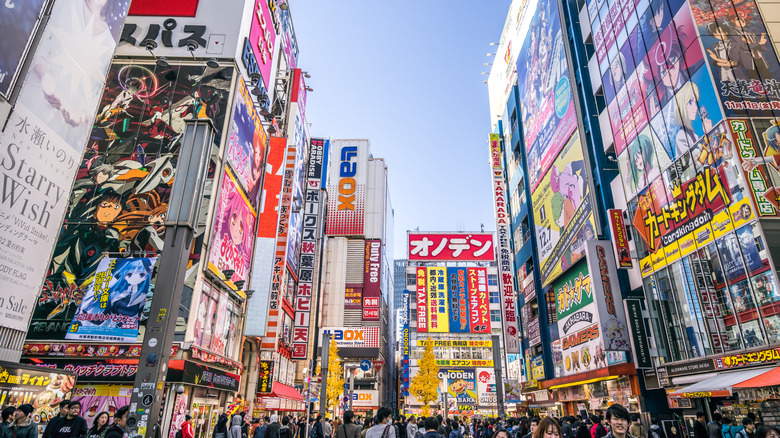Akihabara, Tokyo’s Electric Town, is renowned as the global epicenter of anime culture. Amidst the towering anime stores, however, lies a unique aspect of Japanese hospitality that often puzzles Western visitors: the maid café.
What is a Maid Café?
Maid cafés emerged around the start of the 21st century, initially conceived to cater to anime and manga enthusiasts seeking a more immersive dining experience. While the concept is relatively new, the maid uniform style has older roots. The Lion Café in Ginza was among the first to adopt the traditional Western maid uniform for its servers. This idea remained largely dormant until Cure Café opened in March 2001, marking the birth of the modern “maid café.”
Stepping into a maid café is like entering a fantasy world designed with over-the-top cuteness. Guests are greeted by staff who might address them as “master” or “princess,” in line with the fantasy theme. The maids are there to cater to every need, offering attentive and playful service.
Locals visit maid cafés for various reasons: to enjoy anime fandom with friends, to relax after a stressful week, or simply to feel pampered. Tourists are often drawn by curiosity, expecting a kitsch experience but often finding something surprisingly wholesome. Contrary to assumptions, these establishments are not adult-themed bars but rather akin to a family-friendly fantasy world, where entertainment takes precedence.
The Food: Comfort Classics with a Cute Twist
Food in maid cafés typically consists of simple, comforting dishes commonly found in Japanese cafés and diners. Think omurice (omelet with rice), pasta, Japanese curry rice, and pancakes. However, the presentation sets maid cafés apart. Maids often decorate dishes with doodles and smiley faces, using ketchup or other sauces.
Desserts take the cuteness to another level. Expect visually appealing treats like berry parfaits with teddy bear-shaped biscuits, cream piped into heart shapes, and magic-themed “potion” drinks served in glowing goblets, sometimes with dry-ice effects. Maids often perform “magical chants” over the food, such as “Moe moe kyun,” to infuse it with cuteness.
Given the theatrical experience, prices are generally higher than in regular cafés. Expect to pay around 1,000 yen for omurice, along with an hourly table fee. Despite these costs, maid cafés remain accessible and fun, offering a unique experience at a reasonable price compared to dining in the United States.
Beyond Food: Entertainment and Immersion
Maid cafés offer a fully immersive experience, extending beyond just food and drink. They are fantasy lands where guests can immerse themselves in anime culture through live performances, interactive games, and “magical” rituals.
Maids (or butlers in butler cafés) frequently perform dances, J-pop songs, and audience participation numbers. These performances contribute to the lively and playful atmosphere that defines maid cafés.
Games are also a staple, ranging from rock-paper-scissors to memory challenges. Prizes include stickers, toys, or custom drawings. Some cafés feature scheduled on-stage performances, so checking the schedule beforehand is advisable. Guests are often given glow sticks and accessories to enhance the festive mood.
Photo opportunities with the maids are common, often using Polaroid cameras for instant souvenirs. Maids will often decorate or sign these photos. Note that these photo ops usually involve an extra charge. Photography of staff or other diners is typically restricted outside of official photo sessions.
Choosing the Right Maid Café
Not all maid cafés are the same, and choosing the right one is essential, especially for families. Mainstream cafés like Cure or At-Home Cafe are family-friendly and cater to a wide audience, making them suitable for tourists and groups. These cafés are accessible even for non-Japanese speakers. However, physical contact with staff is strictly prohibited, as they are performers, and guests are expected to treat them with respect.
Smaller, more niche establishments may have a more adult-oriented theme, with low lighting and suggestive entertainment. These cafés are generally geared toward local patrons and may not be suitable for tourists. They often feature provocative photos, late-night hours, and non-English menus. For a mainstream experience, stick to the major chains, which generally allow children (though some have age restrictions, commonly prohibiting entry to children under 10). Checking Google reviews beforehand is also recommended.
Tips for First-Timers
To maximize your maid café experience, consider these tips:
- Reservations: While walk-ins are possible, booking in advance is recommended, especially for popular cafés and weekend visits.
- Table Charges: Be aware of table charges, typically between 500 and 1,000 yen.
- Time Limits: Seatings usually last 60-90 minutes, with options to extend for an additional fee.
- Respect: Treat the maids as performers. Always ask before taking photos, and avoid personal questions or physical contact.
- Have Fun: Approach the experience with an open mind and a willingness to participate. The silliness is part of the charm, offering a glimpse into a unique aspect of Japanese culture.

